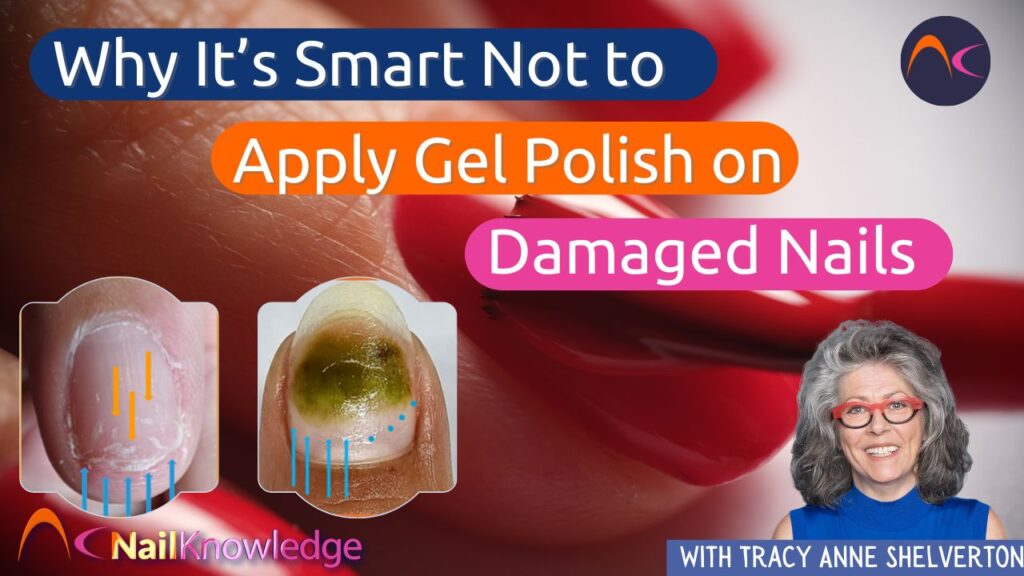Entendendo os riscos de reaplicar o revestimento de unhas sem permitir a recuperação adequada
When your nails are damaged, it’s essential to let the nail plate recover before reapplying any nail coating. Failing to do so can lead to complications, making it important to choose the best plan of action for nail health and appearance.
Visualizando o impacto: Antes e depois
Antes: Normal nail coating after about 10 days, featuring one layer of a Builder Gel for shine and a bit of stability.

Depois: O All Builder In A Bottle arrancou a placa ungueal junto com a borda livre da placa ungueal.

A importância de selar a placa ungueal
If we look at photo 2 and the yellow arrows, we need first to seal the upper layers of the nail plate before applying more Gel Polish, and if we cannot do that a more permanent base coat will need to be applied, if we don’t do this we will create pockets for air, moisture or both under our gel polish
- Air – causes lifting

These pockets can trap various contaminants your nails come into contact with, such as dirt, bacteria, and moisture. If caught early, the product can be removed and replaced to prevent issues. However, if not addressed, trapped moisture can create an ideal breeding ground for opportunistic pathogens like Pseudomonas aeruginosa, leading to potential infections.

O que podemos fazer para evitar que os problemas ocorram?
Accidents happen, we can’t prevent those but our clients can help with good maintenance of their nail enhancements. A good quality oil helps prevent a build up of moisture and also helps to keep your nail and nail coating flexible and less prone to breaking or cracking, so a win win for your client but also for your salon, longer lasting gorgeous nails and happier clients.
É possível recuperar a placa ungueal?
É possível, pois há um produto especial no mercado que está disponível em todo o mundo. Tratamentos como esse selam novamente as camadas superiores da placa ungueal de dentro para fora e você poderá reaplicar o produto para unhas artificiais sem problemas.
Without this product its smart to prep your nail plate with a good nail plate cleanser, and apply a semi-permanent nail product such as acrylic Liquid & Powder – Acryl has more than one advantage over a hard gel or an acrygel, it is designed to remain on a nail plate for longer periods of time and that’s important to know with this kind of nail plate damage, but if necessary, it can also be safely removed by thinning with a nail file and soaking off the last layer for optimal control and no extra damage to the nail plate.
Riscos da aplicação de aprimoramentos de unhas de curta duração em unhas danificadas
Placing a ‘short life‘ nail enhancement on a damaged nail plate is asking for problems and complications – something we would like to avoid in the nail salon. Doing so can create pocket lifting or a great home for opportunistic pathogens that are hanging around waiting to do their thing, recovery of the nail plate after such an infection takes considerably longer than recovering the original damage of the nail coating being ripped off.
It’s a good idea to inform your salon clients about the pros and cons of nail plate and nail unit maintenance with oils and lotions, its not just a sales pitch, your clients are paying you good money for nail coatings – having spent that money they also have a responsibility to keep them in the best possible condition and your responsibility is to provide a safe lasting service with minimal chance of causing infections.
| Fazer | Don’t | Produto para unhas | Consulte o MD |
| Mantenha-se limpo e faça escolhas inteligentes | Disfarçar com produtos para unhas artificiais sem um plano | IBX, óleo e loção | Se a unha ficar infectada ou mudar de cor |
| Use um produto semipermanente para ajudar na recuperação | Use hard gel or an acrygel – removal is difficult | Acrílico -L&P | |
| Oil 4dd’s | Óleo e loção de alta qualidade |
Contraindicação: Se a cliente já apresentar sinais de uma possível infecção, vermelhidão, inchaço ou qualquer alteração na cor, não reaplique NENHUM produto para unhas artificiais. Consulte as diretrizes de higiene, um especialista em cuidados com as mãos ou entre em contato com um médico


